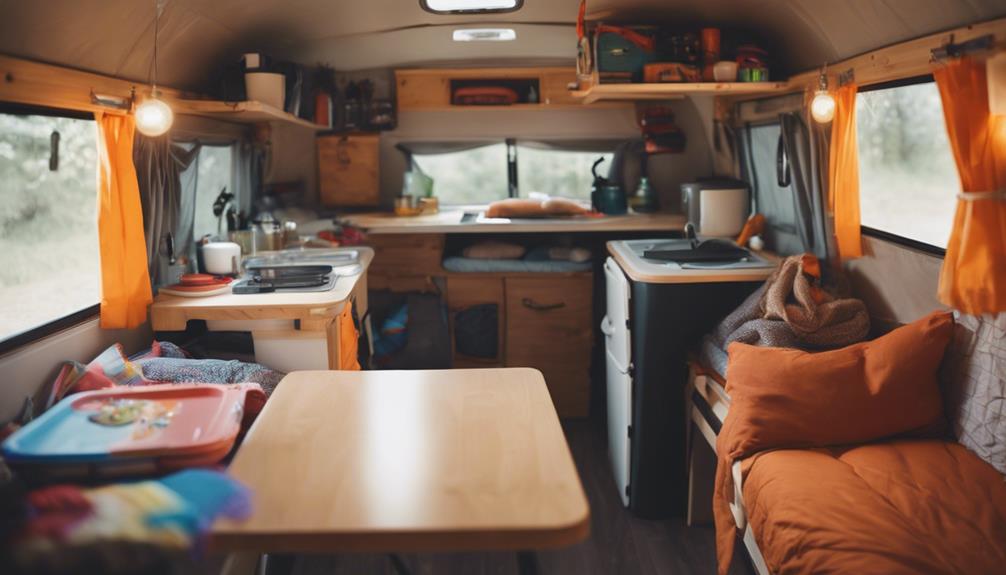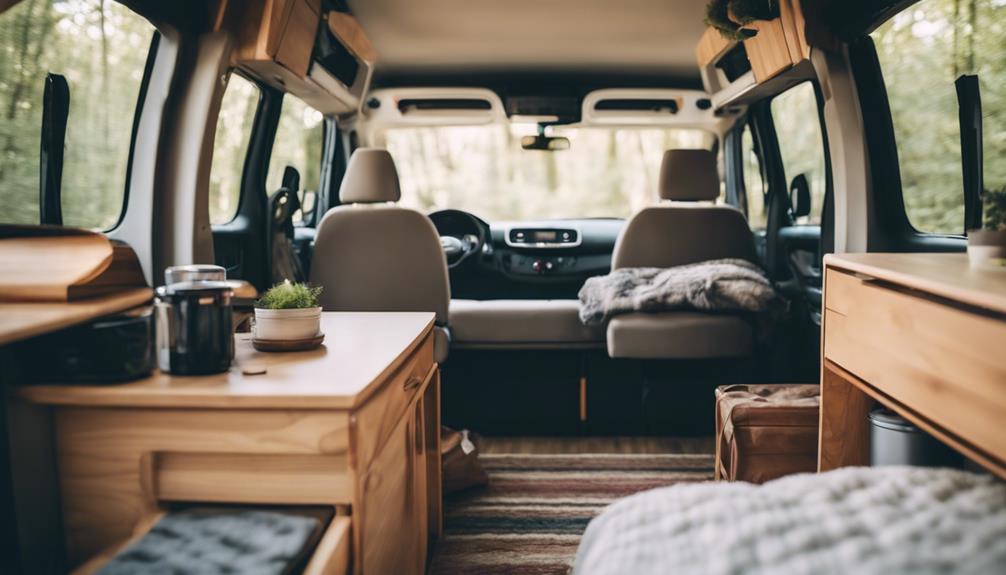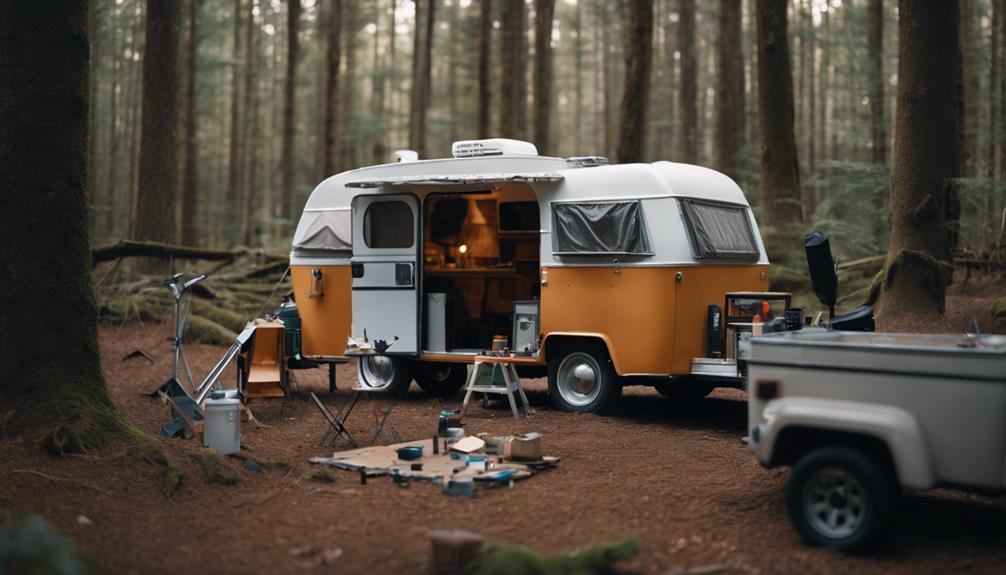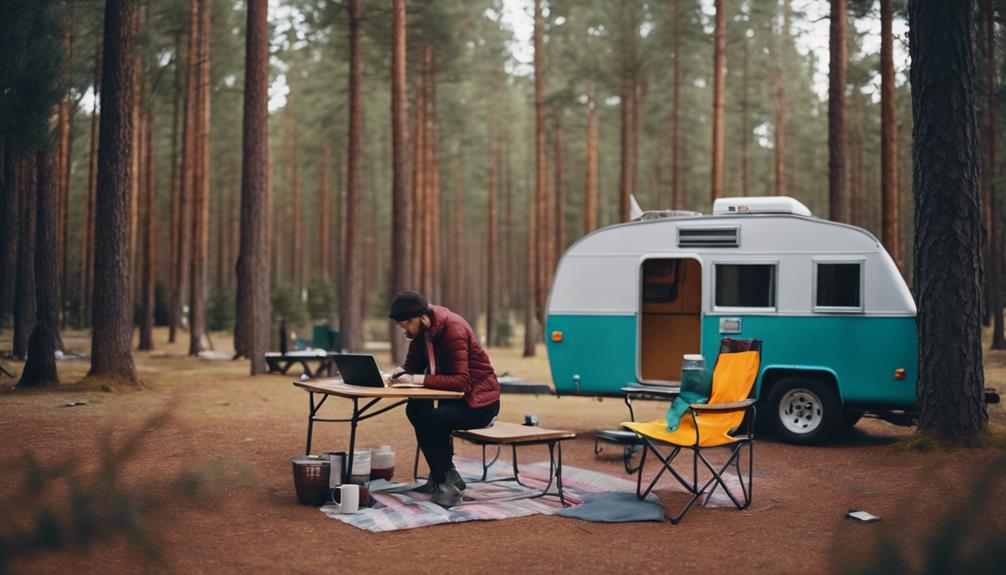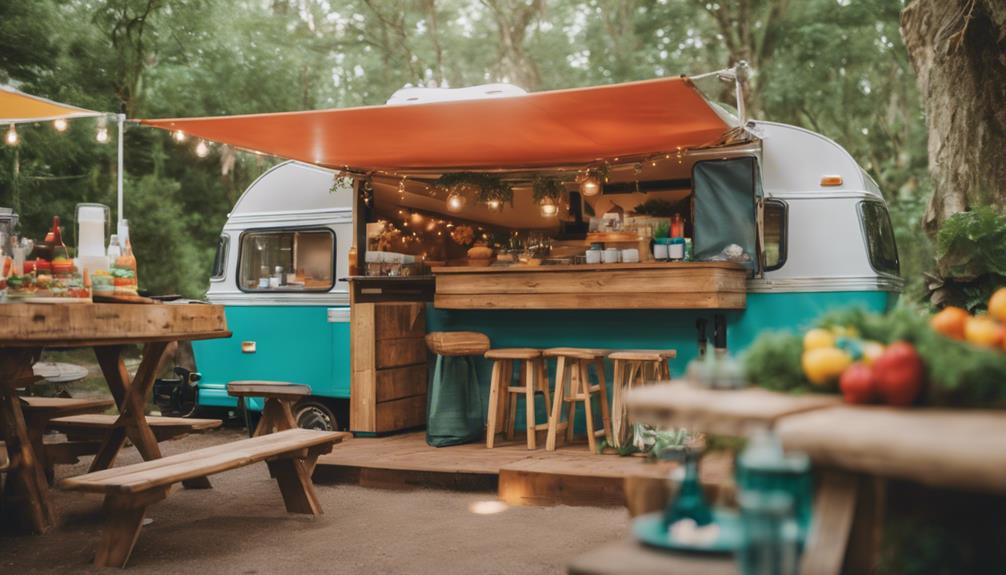To organize things in your pop-up camper and maximize space, start by utilizing vertical storage solutions like hanging shelves and tension rods. Use clear, labeled bins for under-seat storage to keep items visible and accessible. Embrace collapsible kitchen tools and stackable containers for food supplies to minimize clutter. Designate bins for each family member's clothing and personal items. Keep small organizers by beds for easy access to essentials. Don't forget to implement systematized shelves and containers to organize kitchen items efficiently. There are many more strategies to explore that can enhance your camping experience even further.
Key Takeaways
- Utilize vertical and under-seat storage with clear bins to maximize space and keep items organized and visible.
- Opt for collapsible and multi-functional kitchen items to reduce storage needs and enhance efficiency.
- Label containers for clothing, food, and personal items to streamline packing and maintain organization.
- Implement tension rod shelving in the bathroom for toiletries and assign small bins for personal items to enhance accessibility.
Storage Solutions and Techniques
To make the most of your pop-up camper's limited space, you'll want to implement smart storage solutions and techniques that keep everything organized and easily accessible.
Start by utilizing vertical space with hanging shelves and hooks. This way, you can keep items off the floor and within reach. Clear plastic bins are your best friends for under-seat storage; they allow you to easily identify contents while maximizing space efficiency.
When it comes to organizing food supplies, stackable bins are a game changer. Use them both in the camper and your vehicle to minimize clutter and guarantee everything's within easy reach. Don't forget to label bins and containers. This simple step will save you time during packing and unpacking, helping you quickly find what you need.
Additionally, consider using collapsible and multi-functional kitchen items, like measuring cups and bowls, to reduce storage needs.
Organizing Clothing and Personal Items
Keeping your pop-up camper organized isn't just about storage solutions; it also involves efficiently managing clothing and personal items for each family member. By using a combination of small and large plastic bins for clothing storage, you can easily stack and access everything in the limited space. Assign each family member their own designated bin to keep things organized and accessible.
To maximize your vertical space, consider using ceiling hooks and hanging organizers for items like hats and bags. Pre-packing clothing and supplies in labeled bins before your trip can streamline the packing process and help you remember everything. For personal items like phones and books, place small organizers by each bed to guarantee easy access.
Here's a quick overview of organizing tips:
| Family Member | Clothing Storage | Personal Items Storage |
|---|---|---|
| Parent 1 | Large bin (labeled) | Small bedside organizer |
| Parent 2 | Large bin (labeled) | Small bedside organizer |
| Child 1 | Small bin (labeled) | Small bedside organizer |
With these strategies, you'll keep things tidy and make the most of your camper's space.
Food and Kitchen Storage Strategies
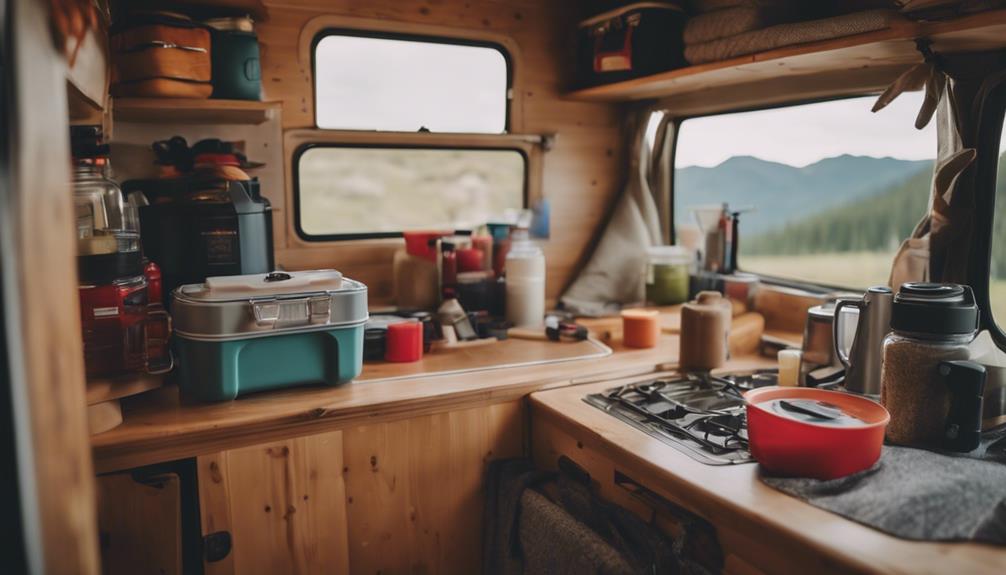
Maximizing food and kitchen storage in your pop-up camper can make meal prep and snack time much more efficient during your adventures. Start by using stackable storage containers to keep dry goods organized and accessible. Clear containers allow you to quickly see what you have, making it easier to grab ingredients when you're cooking.
Consider these strategies for effective kitchen organization:
- Designate a bin for cooking utensils: Use a specific container for essential tools, and utilize smaller plastic storage or cereal containers within to keep everything sorted.
- DIY shelving: If your cabinets allow it, add some shelves to store snacks and coffee at eye level, enhancing accessibility.
Keeping larger kitchen supplies in a dedicated cabinet with a door guarantees they stay secure during travel.
Bathroom and Toiletry Management
Organizing your bathroom and toiletry items efficiently can transform your pop-up camper into a more functional space, making it easier to find what you need when nature calls.
Start by utilizing tension rod shelving above the cassette toilet cabinet. This clever solution maximizes vertical space, giving you a designated spot for all your toiletries.
Next, assign smaller Sterilite 3-drawer units to each family member for their personal items. This way, everyone's belongings are easily accessible and neatly organized. Consider implementing a shared drawer for communal items, such as toothpaste and floss.
Dollar store baskets can help you keep smaller items, like toothbrushes, organized and tidy.
For shower supplies, store them in handy bags and create shower lanyards to keep everything together. This minimizes clutter during bath time and streamlines your routine.
Finally, hang bath towels on towel bars located under the bunkends. This not only provides easy access but also effectively utilizes the limited space in your camper's compact bathroom setup.
With these strategies, you'll make your pop-up camper's bathroom a well-organized haven.
Maintenance and Upkeep Tips

Regular maintenance is essential to confirm your pop-up camper stays in excellent condition and remains ready for your next adventure. By keeping up with cleaning and organization, you'll not only prolong the life of your camper but also enhance your camping experience.
Here are a few tips to help you maintain your camper effectively:
- Regularly check seals and canvas: Inspect for leaks and address any issues to prevent water damage.
- Deep clean twice a year: Ascertain all areas, including storage space and sleeping zones, remain hygienic and functional.
Don't forget to create laminated supply lists for your camper essentials and food staples, updating them regularly for easy tracking during trips. This organization helps you stay prepared while maximizing your camper's storage space.
With these maintenance and upkeep tips, you'll be ready to hit the road without worry, confirming your pop-up camper is always in top shape for your next getaway.
Comfort and Climate Control Ideas
When it comes to comfort in your pop-up camper, managing temperature and airflow is key.
You can enhance your sleeping experience with cozy bedding solutions and improve insulation and ventilation to create a more inviting space.
Let's explore some effective techniques to keep your camper comfortable, no matter the weather.
Temperature Regulation Techniques
To keep your pop-up camper comfortable in varying weather conditions, focus on effective temperature regulation techniques that enhance both comfort and climate control.
You'll want to guarantee proper ventilation and air circulation, especially when the weather gets extreme.
Here are three key strategies to take into account:
- Reflective window covers: Install these to minimize heat gain from the sun, keeping your interior cooler during hot days.
- Portable fans: Use these to boost air circulation, which is essential if your camper lacks built-in air conditioning.
Additionally, be sure to utilize roof vents or windows to facilitate airflow.
This not only helps with temperature regulation but also reduces humidity, creating a more pleasant atmosphere inside your camper.
Insulation and Ventilation Tips
Effective insulation and proper ventilation are vital for maintaining a comfortable climate inside your pop-up camper, guaranteeing you stay cozy in any weather.
Start by installing reflective window coverings or insulated curtains to minimize heat loss during cooler nights and reduce heat buildup on sunny days. This simple addition notably enhances your insulation.
Next, focus on airflow to guarantee proper ventilation. Utilize built-in roof vents and windows to promote airflow, helping regulate temperature and reduce moisture accumulation. You might also consider adding a small, portable fan or heater. This allows you to adjust the climate control based on the weather conditions while camping.
Regularly check the seals and canvas for wear and tear. Confirming these parts are in good condition is vital for maintaining insulation and protecting against drafts or leaks.
Additionally, reupholstering cushions with polyester batting not only adds comfort but also contributes to insulation, creating a cozier atmosphere inside your camper.
Cozy Bedding Solutions
Creating a cozy sleeping environment in your pop-up camper can make all the difference in guaranteeing a restful night's sleep while you're out in nature. To maximize comfort and efficiently use your limited space, consider these bedding solutions:
- Memory foam mattress or topper: Enhance comfort on dinette beds for a better night's sleep.
- Layered bedding: Use lightweight blankets for warmth without bulk, making packing easier.
To further organize your bedding, guarantee each item can be easily folded or rolled for quick access.
Utilize your storage area wisely by placing bedding underneath benches or in other hidden compartments.
Incorporating polyester batting when reupholstering cushions can add softness and warmth on cooler nights, making your camper feel more like home.
Remember, the key is to balance comfort with space efficiency, so you can enjoy your camping trip without feeling cramped.
With these tips, you'll create a cozy haven that allows you to recharge for your next adventure.
Utilizing Vertical and Under-Seat Space

Maximizing vertical and under-seat space in your pop-up camper can greatly enhance organization and accessibility during your trips. Start by utilizing vertical space with hanging shelves or tension rods. These options keep your items organized without taking up valuable floor space. You can also install ceiling hooks for additional hanging storage, allowing you to free up counter space for other essentials.
For under-seat storage, clear bins are a game-changer. They enable easy visibility and quick access to clothing, shoes, and supplies while you're on the road. Designate specific under-bench areas for various items, using labeled containers to streamline your organization and prevent clutter.
Consider incorporating collapsible storage solutions, such as folding bins or baskets. These can be easily stored away when not in use, ensuring your camper stays tidy.
Organizing Miscellaneous Supplies
After optimizing your vertical and under-seat space, focus on organizing miscellaneous supplies to keep your pop-up camper clutter-free and functional during your trips.
Start by implementing three smaller bin sets for items like kids' games, first-aid kits, and sundries. This helps you organize and keep everything contained, making it easy to access when needed.
Consider the following tips:
- Use labeled storage containers for vitamins and allergy medications, ensuring you can find essential supplies quickly.
- Store blue bins under the counter while traveling; once you set up at the campsite, you'll have convenient access to your items.
Additionally, think outside the box! Repurpose items like metal collapsible dog kennels for extra storage solutions.
Community Resources and Support
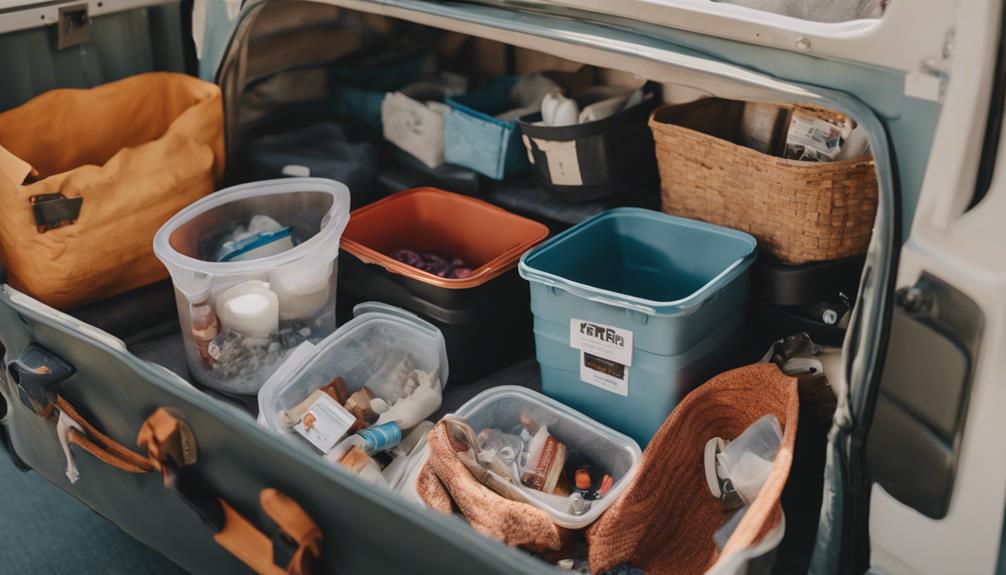
Engaging with online communities can provide valuable insights and support for organizing your pop-up camper effectively. Platforms like Pinterest and camping blogs are treasure troves of tips and ideas.
You'll find a wealth of resources from fellow camper enthusiasts who share their experiences and strategies for maximizing space. This collaborative environment can inspire you and offer solutions to common organizing challenges.
Don't hesitate to reach out for advice—Bree, for instance, offers email support and encourages new campers to connect. This fosters a sense of community, making it easier for you to troubleshoot and find inspiration.
The feedback from these communities often highlights the importance of detailed visuals and practical organization strategies, which can help you replicate successful setups in your own camper.
DIY Ideas for Camper Organization
When you're organizing your pop-up camper, think vertically to maximize your limited space.
Using tension rods and DIY shelves can help you create efficient storage solutions that keep everything within reach.
Plus, incorporating collapsible items can make it easy to maintain a tidy environment while still having room for your essentials.
Vertical Storage Solutions
Maximizing vertical storage in your pop-up camper can transform cramped spaces into organized havens. By using effective vertical storage solutions, you can enhance accessibility and keep your essentials neatly arranged. Here are some DIY ideas to contemplate:
- Hanging shelves: Use tension rods to create hanging shelves above the cassette toilet for toiletries, freeing up valuable floor space.
- Wall-mounted hooks: Install these to keep lightweight items like keys and utensils organized, making them easy to reach while minimizing clutter on surfaces.
Additionally, contemplate installing over-the-sink shelving units to store dish-drying and cooking supplies, saving counter space. You can also incorporate hanging shoe racks on the inside of cabinet doors for visible organization of small items like snacks or first-aid supplies.
These vertical storage solutions not only maximize space but also create a more functional and enjoyable camping experience. By implementing these ideas, you'll find that your pop-up camper can feel more spacious and organized than ever before.
Collapsible Item Utilization
Incorporating collapsible items into your pop-up camper organization can greatly enhance your space efficiency, complementing the vertical storage solutions you've already implemented.
Start with collapsible bowls and measuring cups in your kitchen; they save space and make storage easy when not in use. Consider adding foldable cups to your gear—these minimize bulk and enhance portability during your trips.
When it comes to laundry, collapsible laundry bins are a game changer. They expand when needed but easily collapse for storage, optimizing space management in your camper.
To further streamline your setup, invest in multi-functional tools, like a pot that doubles as a bowl. This will help reduce the number of items you carry, maximizing your storage efficiency.
Lastly, don't overlook the power of magnetic strips. Use them to hang lightweight, collapsible items like measuring spoons or small utensils, keeping them organized and easily accessible without taking up counter space.
Frequently Asked Questions
Where to Put Your Clothes in a Pop-Up Camper?
You can store your clothes in plastic drawers for each family member, using clear bins under benches for easy access. Hang items using ceiling hooks and tension rods to keep everything organized and off the floor.
How Do I Maximize Space in My Camper Van?
To maximize space in your camper van, install vertical shelves, use clear bins for under-seat storage, and opt for multi-functional items. Label containers for easy access and utilize magnetic strips to keep utensils organized.
How Do You Balance a Pop-Up Camper?
To balance a pop-up camper, you've gotta be a weight wizard! Distribute heavy items evenly, secure everything tightly, and check your tire pressure. It's all about keeping things stable for a smooth, worry-free ride!
How Can I Increase My RV Storage?
To increase your RV storage, utilize vertical space with shelves and hooks, incorporate under-seat bins for visibility, choose collapsible items, and regularly declutter. These steps will help you maximize your available space efficiently.
What Organizational Tips Can Help Maximize Space in an Enclosed Pop-Up Camper?
When it comes to enclosing a popup camper, organization is key. Use hanging organizers, collapsible storage bins, and multi-purpose furniture to maximize space. Utilize vertical storage by adding shelves and hooks. Keep items organized and secure during travel to make the most of the limited space.
Conclusion
By implementing these organization strategies, you'll transform your pop-up camper into a cozy haven, maximizing every inch of space.
Think of it as a puzzle; when each piece fits just right, the whole picture comes together beautifully.
Embrace the journey of organizing, and you'll find that not only does your camper feel more inviting, but it also enhances the adventures waiting ahead.
So plunge in, get creative, and make your camper a reflection of your unique style and needs!

